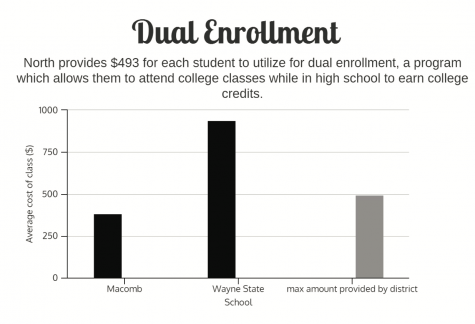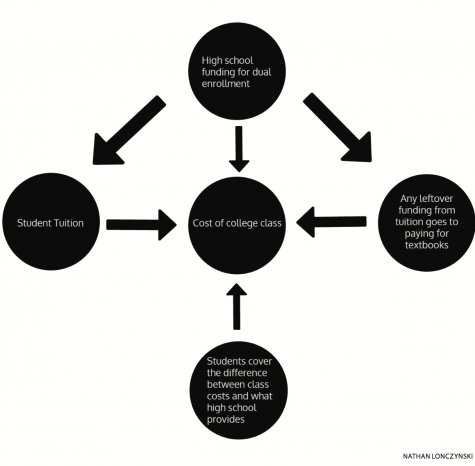College classes paid for by school
March 16, 2016
Money is tight and the burden of college tuition isn’t helping. Prices for tuition have increased by 79.5 percent from 2003 to 2013, according to the U.S. Labor Department.
However, in order to ease the financial restraint, the school district gives money to high school students who attend college classes to earn credits towards college graduation. This program is called dual enrollment and it enables students to fulfill up to 10 credits before college so they will not have to pay to take those courses at their future school. 2015 alumnus Harris Bunker enrolled in multivariable calculus during his senior year, driving with fellow alumnus Bobby McGovern twice a week to Macomb Community College.
 “Yes (dual enrollment) is a challenge, but if you’re taking legitimate courses in it, ones that you know are gonna give you college credit, you’re going to save money and give yourself a leg up once you get to college,” Bunker said. “It’s definitely worth it.”
“Yes (dual enrollment) is a challenge, but if you’re taking legitimate courses in it, ones that you know are gonna give you college credit, you’re going to save money and give yourself a leg up once you get to college,” Bunker said. “It’s definitely worth it.”
The credits then transferred towards Bunker’s economics major at Michigan State University, allowing him to complete the calculus sequence as a freshman. Not only does the program benefit students’ wallets, but a national study by the University of Iowa in 2013 revealed that students who took dual enrollment courses were 10 percent more likely to complete a Bachelor’s degree than the comparison group.
Counselor Barbara Skelly believes dual enrollment is great way for students to get adjusted to college life and earn college credits. Students can get involved by discussing the option with their counselor and an admissions adviser.
“Some kids feel ready to start their college careers even though they’re in high school and this gives them the opportunity to do it,” Skelly said. “I think students should take advantage of this opportunity because it’s a great way to get started on college credit while they’re in high school.”
STEM-related lessons and foreign languages rank as two of the most common college classes for high school students. Junior Eve Feldman takes a sign language class at Macomb and found that it led her to a career she would like to pursue.
“It’s really showed me how much I like signing and using my hands instead of talking because it’s more expressive, it uses more emotions and it feels more personal than speaking is,” Feldman said. “I think dual enrollment for classes that North doesn’t have, especially a language that they don’t have, (are) a good idea because the only way you’re goin g to get better at a language is if you keep (speaking) it.”
g to get better at a language is if you keep (speaking) it.”
For students who’ve completed the amount of foreign language classes offered at North, colleges offer solutions for those who fear losing the language after a gap.
After spending junior year in Spanish 5 AP, senior Sarah Cherry decided to continue learning the language at the University of Detroit Mercy.
“I think it’s a great idea. It’s gotten me more experienced with the language that you didn’t necessarily have in high school,” Cherry said. “It’s more speaking in Spanish than solely composition and framed dialogue.
Although the college credit end result is the same, the difference between AP classes and dual enrollment is evident.
“AP is definitely easier than dual enrollment on the whole. Teachers definitely care more about your personal stake in the class because you’re there five days a week,” Bunker said. “My professor last year, while he was a nice guy, Professor Williams, he didn’t have the one-on-one—I’m not sure if he actually knew my name, for example.”
Based on her successful experience in the program, Feldman would recommend dual enrollment to other students.
“I think (dual enrollment) could really give you a great insight on what college life is like because it’s at a college,” Feldman said. “I think if you have the opportunity and the purpose to take a dual enrollment course you should.”











